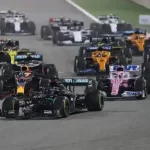Formula One is the pinnacle of motor racing, producing the fastest and most technologically advanced cars in the world. Formula 1 engineers are always on the look for new tools and technologies that can make the sport safer, more efficient and more impressive as a whole. When you’re racing at 350kph, every second counts and new ways are constantly sought to improve lap times. Technologies used in the Formula One racing cars are the result of very long research, requiring the best scientific expertise.
The following are technologies used by F1 cars.
- KERS

The Kinetic Energy Recovery System was introduced in 2009. It was designed to capture energy from the rear car axle and brakes using either an electrical system or a spinning mechanical flywheel that is used to boost acceleration. It could hold up to 60 KW of energy. The power accumulated is then pumped into the drivetrain for a specific number of seconds per lap, effectively creating a hybrid race car.
In racing, KERS has been supplanted (or enhanced) by several new systems that can convert heat energy or kinetic energy into electricity for use by powerful electric motors that generate twice as much output as the original KERS design. On the street, Mazda has experimented with the i-Eloop flywheel recapture system on the Mazda6 sedan.
- J-Damper/Inerter
This technology uses dampers to absorb suspension loads by using a proportional force to cancel them out by way of a rotating mass attached to a damper node and a flywheel. For an F1 car to properly perform aerodynamically as well as reduce tire deflection and maximize the vehicle’s contact patch through corners, the suspension needs to be as stiff as possible. The resultant bouncing compromises the traction. However, the presence of the J-Damper reduces such an effect.
- Active Suspension

Introduced by Peter Wright of Lotus; It uses a synthetic spring linked to an electronic monitor. It uses data collected from circuits to predict the road ahead and adjust the suspension accordingly. Active suspension made the car’s massive downforce controllable . It also endured a constant ride height and maximized grip and aerodynamic efficiency. Unfortunately, it was banned in 1994 due to fears of increased cornering speed.
- Steering Wheel Control and Displays

 Formula One steering wheels look nothing like what you grip in your hands on your morning commute. These rectangular slabs pack as many buttons, toggles, screens, and dials as possible between their padded hand grips, allowing the driver to adjust engine and drivetrain performance, communicate with the rest of the team in pit lane, shift gears, and monitor vehicle data in real-time. The reason these wheels are so complex is because regulations prohibit crew members from making adjustments to the car remotely, putting all of that responsibility on the driver – while they’re driving at speeds that dictate keeping their eyes on the path ahead.
Formula One steering wheels look nothing like what you grip in your hands on your morning commute. These rectangular slabs pack as many buttons, toggles, screens, and dials as possible between their padded hand grips, allowing the driver to adjust engine and drivetrain performance, communicate with the rest of the team in pit lane, shift gears, and monitor vehicle data in real-time. The reason these wheels are so complex is because regulations prohibit crew members from making adjustments to the car remotely, putting all of that responsibility on the driver – while they’re driving at speeds that dictate keeping their eyes on the path ahead.
- Monocoque Chassis

This tech is made of a single load bearing piece, rather than piecing a separate body on top of a discrete frame or using a space frame. This effectively made the car light weight, improved acceleration, top speeds and fuel efficiency. The modern designs by McLaren sees the production of the chassis with carbon fiber monocoque.
- Carbon Fiber

F1 monocoque constructors turned to carbon fiber after reaching the limits of what aluminum had to offer in the early ’80s. This composite’s exceptional strength was first used to protect McLaren drivers by forming a safety cell around them within the monocoque design of the race car, but eventually, carbon fiber would be woven into the entire F1 chassis and body as a way of further reducing the mass of the race card without sacrificing protection or performance. Carbon fiber is often used in a weave with other materials such as Kevlar and aluminum to create a honeycomb sandwich that is twice as strong as steel at one fifth the mass. It’s also become popular for use with high-end sports cars as both a styling flourish and a genuine structural component, typically found in spoilers, wings, and roof panels.
- Traction Control

This system uses electronic sensors to automatically manage how much power is being put down to the pavement in an effort to prevent wheel spin. It is the closest thing to an auto pilot. It reduces the power to the wheels in the event of wheel spin, allowing for a more controlled acceleration, perfect starts and the elimination of drift. However, it was banned first in 1994, brought back In 2001, and outlawed in 2008.
- The Plank
Did you know that each modern F1 car has a piece of wood attached to its belly? Also called a skid block, this unique rectangular slab is there to prevent teams from cheating on ground clearance. In the rulebook since 1994, this beechwood composite material must remain 10 mm thick across its entire length and width, with a tolerance of 1 mm in either direction to account for occasional rubbing. Each block is measured at the end of a race to check for excessive wear, which can disqualify a team from competition.
- Semi-automatic Gears
Debuted in the 1989 Ferrari driven by Nigel Mansell, semi-automatic gears use a two-shift barrel system to eliminate the need for a driver-controlled clutch. Those early ’90s boxes changed gear in 30-50 milliseconds rather than 200-250 milliseconds, with later developments introducing seamless-shift boxes. They’re also controlled using those super-cool paddles behind the steering wheel. Providing faster gear changes, while also allowing the driver to keep both hands on the steering wheel, semi-automatic gears had a profound change on ’90s racing. But they also ushered in the era of the modern composite steering wheel, the Wii U-style amalgam of paddles, buttons, toggles, switches and screens which allow drivers to monitor and control every facet of the car’s performance, from fuel mix to brake bias.
Formula One is a race where technology is everything, the cars are so advanced that there isn’t much room for man to make a difference. Still, there are plenty of innovations that a driver can use to his advantage as he pushes speed and power to the absolute maximum. Racing driver Lewis Hamilton agrees: “The car’s my office and I want to be in the best possible environment, so if I can find ways in which that happens I’ll take it.”

